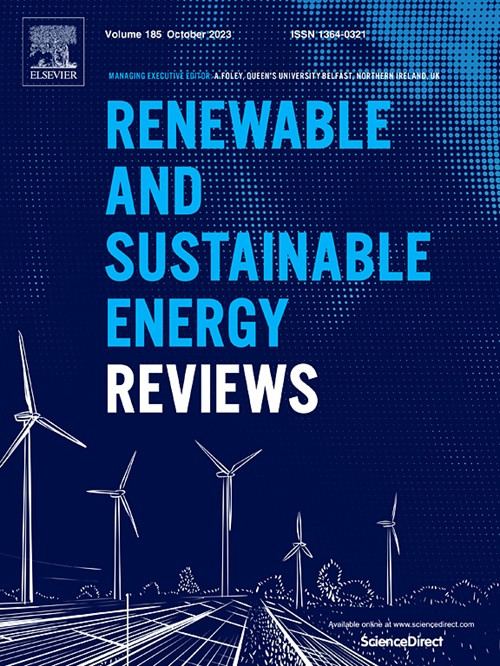以浸没式冷却为重点的电池热管理综述
IF 16.3
1区 工程技术
Q1 ENERGY & FUELS
引用次数: 0
摘要
温度对电池的性能、循环寿命和安全性影响很大。然而,快速充放电会显著增加发热量,导致电池温度迅速上升。因此,采用合适的电池热管理系统将电池温度保持在理想的范围内是至关重要的。温度均匀性对电池的循环寿命和工作性能起着至关重要的作用。为了评估不同电池热管理系统的温度均匀性的局限性,本文对各种冷却技术进行了全面的比较。其中浸没冷却因其热效率高、热阻小,温度均匀性最好。两相浸入式冷却系统即使在高达20℃的超高充放电速率下,也能将温度及其均匀性保持在理想范围内。此外,本文还比较和评价了用于浸没冷却的不同介质流体,讨论了最适合电池系统的冷却剂,并总结了浸没冷却的最新进展。总结了浸没式冷却在电池热管理中的优点和缺点,包括温度波动、极端条件下温度分布不均和热失控。此外,还深入分析了各种电池热管理系统的经济效益和环境效益。浸没冷却显示最低的碳足迹和优越的环保性能。最后,综述强调了浸入式冷却的关键挑战和未来发展方向,包括介电流体、系统稳定性和集成以及电池安全性方面的进展。该研究对电池浸入式冷却技术进行了全面和最新的回顾,为推进电池热管理系统提供了有价值的见解,并支持向可持续经济和零排放的过渡。本文章由计算机程序翻译,如有差异,请以英文原文为准。
A review of thermal management of batteries with a focus on immersion cooling
The performance, cycle life and safety of batteries are strongly influenced by temperature. However, fast charging and discharging can significantly increase heat generation, causing the battery temperature to rise rapidly. Therefore, it is essential to employ suitable battery thermal management systems to maintain the battery temperature within an ideal range. Temperature uniformity plays a critical role in determining battery cycle life and operational performance. To evaluate the limitations of temperature uniformity across different battery thermal management systems, this review provides a comprehensive comparison of various cooling techniques. Among these, immersion cooling demonstrates the best temperature uniformity due to its high thermal efficiency and low thermal resistance. The two-phase immersion cooling system could maintain temperature and its uniformity within an ideal range even during ultra-high charging and discharging rates of up to 20C. Additionally, this review compares and evaluates different dielectric fluids used in immersion cooling to discuss the most adaptable coolants for battery systems and summarizes the latest developments in immersion cooling. Besides, the advantages and disadvantages of immersion cooling are summarized for battery thermal management regarding temperature fluctuation, temperature maldistribution under extreme conditions, and thermal runaway. Furthermore, the economic and environmental benefits of various battery thermal management systems are thoroughly analyzed. Immersion cooling demonstrates the lowest carbon footprint and superior environmental performance. Finally, the review highlights the critical challenges and future directions for immersion cooling, including advancements in dielectric fluids, system stability and integration, and battery safety. This study provides a comprehensive and up-to-date review of battery immersion cooling, offering valuable insights to advance battery thermal management systems and support the transition toward a sustainable economy and zero emissions.
求助全文
通过发布文献求助,成功后即可免费获取论文全文。
去求助
来源期刊

Renewable and Sustainable Energy Reviews
工程技术-能源与燃料
CiteScore
31.20
自引率
5.70%
发文量
1055
审稿时长
62 days
期刊介绍:
The mission of Renewable and Sustainable Energy Reviews is to disseminate the most compelling and pertinent critical insights in renewable and sustainable energy, fostering collaboration among the research community, private sector, and policy and decision makers. The journal aims to exchange challenges, solutions, innovative concepts, and technologies, contributing to sustainable development, the transition to a low-carbon future, and the attainment of emissions targets outlined by the United Nations Framework Convention on Climate Change.
Renewable and Sustainable Energy Reviews publishes a diverse range of content, including review papers, original research, case studies, and analyses of new technologies, all featuring a substantial review component such as critique, comparison, or analysis. Introducing a distinctive paper type, Expert Insights, the journal presents commissioned mini-reviews authored by field leaders, addressing topics of significant interest. Case studies undergo consideration only if they showcase the work's applicability to other regions or contribute valuable insights to the broader field of renewable and sustainable energy. Notably, a bibliographic or literature review lacking critical analysis is deemed unsuitable for publication.
 求助内容:
求助内容: 应助结果提醒方式:
应助结果提醒方式:


